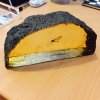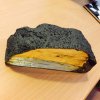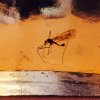cavx
Master Member
Thanks for the comments. I wouldn't mind doing a run, but am really struggling on the cranefly front. I have one in my freezer which I'll have a go with at the weekend. Also have some more accurate amber pigment on the way.
I think this is why you cooked the last fly. The fly contains liquid and when stored in the freezer is either going to be really cold or really wet and neither is good to drop into resin which sets of an exothermic reaction as it cures. Adding too much catalyst will also cook anything your wanting to embed as well. Placing the fly in the raw resin (regardless if it equal parts or a catalyst additive) will keep the air off it and "preserve" it at room temperature.
When you are ready to add the resin soaked fly to the prop, there will be enough contact with mixed resin to cure it. Even if it didn't cure, it is now 100% enclosed by cured resin and will be fully preserved.


















